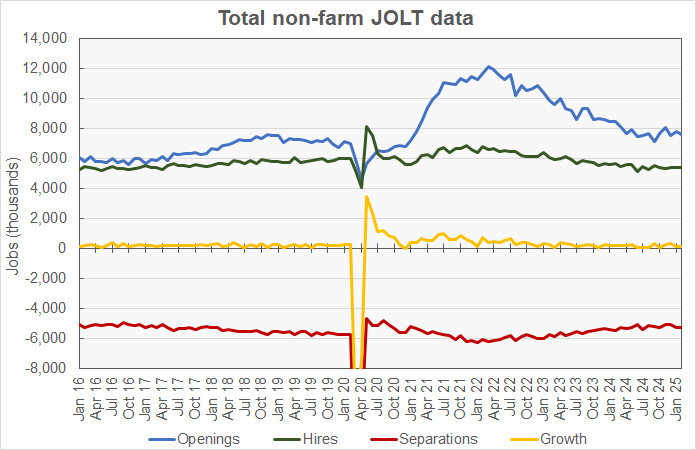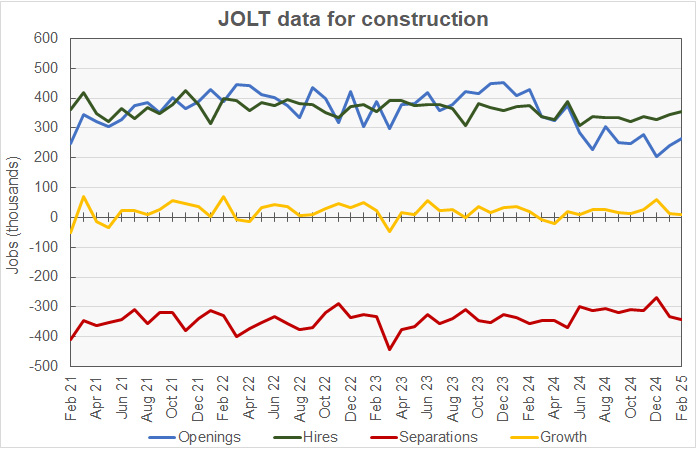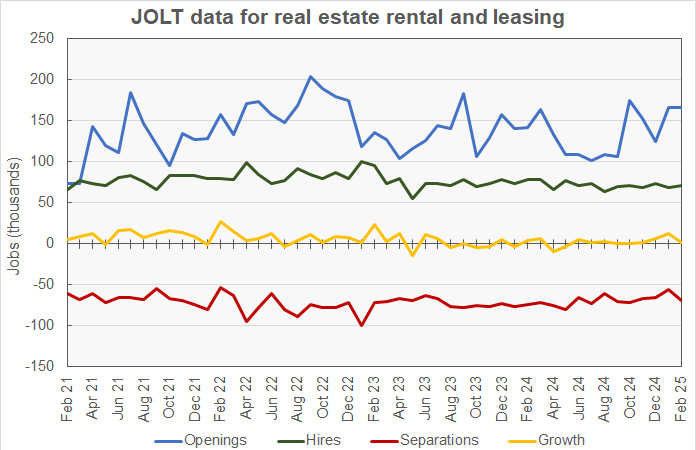The Job Openings and Labor Turnover (JOLT) report from the Bureau of Labor Statistics (BLS) said that the number of job openings in February was 7.57 million. Job openings in construction were up for the month while job openings in real estate renting and leasing were reported to be unchanged.
Job openings were reported to be down 194,000 openings month-over-month. However, the openings figure for January was revised higher by 22,000 openings, so the February openings figure is only 172,000 lower than the initial level reported for January last month. Job openings are down 877,000 openings from their year-ago level.
Hiring was reported to be up from last month’s revised (-22,000) figure for the economy as a whole, rising 25,000 to a level of 5.40 million hires. Total separations fell 11,000 from last month’s revised (+20,000) figure to a level of 5.26 million. Within total separations, quits were reported to fall 1.8 percent while layoffs rose 6.9 percent. Quits represented 60.7 percent of total separations for the month, slightly below the trailing 12-month average of 62.0 percent.
Overall openings down but hiring rises and quits fall
The February job openings figure represents 4.5 percent of total employment plus job openings. For comparison, the unemployment rate in February was reported to be 4.1 percent and 7.05 million people were unemployed. Another 5.66 million people said that they would like a job but were not counted as being in the labor force since they were not actively seeking employment.
For a discussion of the JOLT report and how it relates to the Employment Situation Report, please see the paragraph at the end of this article.
The excess of hiring over separations in the February JOLT report implies an employment increase of 135,000 jobs for the month. Last month’s employment increase was revised to 99,000 jobs, down by 42,000 jobs from the gain reported last month.
Of those leaving their jobs in February, 3.20 million quit voluntarily, while 1.79 million people were involuntarily separated from their jobs. The remainder of people leaving their jobs left for other reasons, such as retirements or transfers. The portion of people quitting their jobs fell 0.1 percentage point from last month’s figure to 2.0 percent of the labor force. The involuntary separations rate was up slightly from last month’s figure at 1.1 percent.
Total non-farm JOLT data since January 2016 is shown in the first chart, below. It shows that hiring, separations and job growth are all now close to where they were in 2016, but job openings remain elevated compared to 2016 levels.

Construction job openings have shifted lower
The next chart, below, shows the employment situation for the construction jobs market over the last 49 months. It shows that February saw a net gain of 10,000 construction jobs, down from last month’s revised gain of 13,000 jobs.

The preliminary job openings figure for February was reported to be up by 22,000 openings from last month’s revised (+6,000) figure at 264,000 openings. Openings were reported to be down 38.5 percent from last year’s level and were reported to represent 3.1 percent of construction employment plus job openings.
Hiring was reported to be up by 8,000 jobs in February from the prior month’s revised (-7,000) jobs figure at 354,000 new hires. The number of construction jobs that were filled in February was reported to be down 5.4 percent year-over-year.
Since last June, construction job openings have averaged 256,000 per month, but in the prior 12 months, they averaged 398,000 per month. So recently, there have been, on average, 36 percent fewer construction jobs available than in the prior period. However, the drop off in hiring has been much less dramatic. Since June, new hires have averaged 334,000 per month while they averaged 362,000 in the 12 months before June, an 8 percent decline. Despite fewer job openings, monthly construction employment gains have been about 10 percent higher on average in the period since June than in the prior 12 months, 22,200 to 19,400.
Construction jobs total separations were reported to rise by 11,000 jobs from the prior month’s revised (-2,000) figure to 344,000 jobs.
Quits were reported to rise by 17,000 jobs from January’s revised (-2,000) figure to a level of 181,000 jobs. Quits represented 52.6 percent of separations for the month.
Layoffs were reported to fall by 4,000 from last month’s revised (-1,000) figure to 145,000 jobs.
“Other separations” which includes retirements and transfers, were reported to be down 3,000 at 10,000 jobs.
RERL job openings steady
The last chart, below, shows the employment situation for the real estate and rental and leasing (RERL) jobs category. Employment in this jobs category was reported to be up 2,000 jobs for the month.

The number of job openings in the RERL category was reported to be 166,000 jobs at the end of February. This was unchanged from the revised (-4,000) level reported for the month before. RERL job openings are up 16.9 percent from their year-ago level. Job openings in the RERL category represent 6.3 percent of total employment plus job openings, down 0.1 percentage points from the level in last month’s report.
Hiring in February was reported to be up by 3,000 jobs from last month’s revised (+2,000) figure at 71,000 jobs. The hiring figure was down 9.0 percent from the level of the year before.
Total separations in the RERL jobs category in February were up by 13,000 from January’s revised (-7,000) figure at 69,000 jobs.
Quits were down by 12,000 from January’s revised (-1,000) figure at 38,000 jobs. Quits represented 55.1 percent of total separations. Layoffs were reported to rise by 24,000 from January’s revised (-6,000) figure to 28,000 jobs. After revision, last month’s layoffs figure was only 4,000 jobs. This is the first time that layoffs have been less than 10,000 jobs since July 2001.
The numbers given in the JOLT report are seasonally adjusted and are subject to revision. It is common for adjustments to be made in subsequent reports, particularly to the data for the most recent month. The full current JOLT report can be found here.
Comparing the reports
The US labor market is very dynamic with many people changing jobs in any given month. The JOLT report documents this dynamism by providing details about job openings, hiring and separations. However, it does not break down the jobs market into as fine categories as does the Employment Situation Report, which provides data on total employment and unemployment. For example, while the Employment Situation Report separates residential construction from other construction employment, the JOLT report does not. The Employment Situation Report separates residential property managers from other types of real estate and rental and leasing professionals, but the JOLT report does not. However, the JOLT report provides a look at what is driving the employment gains (or losses) in broad employment categories.













